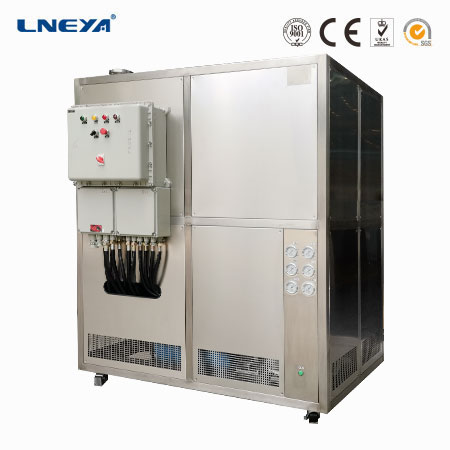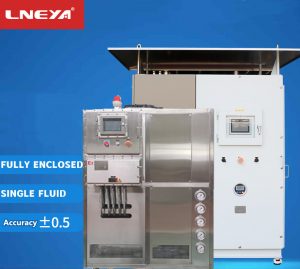Heat transfer oil chemical temperature control system product application
The heat transfer oil heating and cooling temperature control system is a device with heating or lowering at the same time, that is, when the temperature of the equipped glass reactor, rotary evaporator, extraction equipment and other devices needs to be raised or lowered rapidly to reach the set temperature. The heating and cooling of the equipment can be changed quickly, and the medium (heat-conducting oil) used is the same medium, which improves the disadvantage that two different instruments are needed for heating and cooling in the past. Not only improves production efficiency, but also more convenient to use.

The temperature requirements for the reaction of different materials are different:
There are many kinds of chemical products, and the temperature requirements for different materials to react are different. Some reactions can only be carried out until the endothermic temperature reaches a certain temperature, while some reactions can release a large amount of heat energy, which requires the heat transfer oil heating and cooling temperature control system to be able to Dynamically respond and implement heating and cooling control within the reactor.
To ensure accurate and stable temperature control:
In order to ensure the accuracy and stability of temperature control, the chemical production process also requires the temperature control equipment to have a high and low temperature integrated heat transfer oil heating and cooling temperature control system to respond quickly to temperature control, to have high temperature switching efficiency, and to quickly achieve the set target temperature. Meet the temperature requirements of the reactor in the reactor.
Application of heat transfer oil heating and cooling temperature control system:
The heat transfer oil heating and cooling temperature control system refers to a device specially designed for multi-point temperature control by the same unit. It is also very suitable for the site where the on-site working space is required.
The difference from ordinary heat transfer oil heating and cooling temperature control system:
The heat-conducting oil heating and cooling temperature control system equipment can control the temperature independently and can bring two hosts, (the ordinary heat-conducting oil heating and cooling temperature control system cannot be realized). Although the dual-machine integrated equipment is composed of two independent systems, it can be driven only by connecting a power cord (ordinary heat-conducting oil heating and cooling temperature control systems want to achieve dual-channel independent temperature control, two heat-conducting oil heating and cooling temperature control systems must be used , Need to connect two main power lines, the installation also takes a little more work and the price is much higher than the dual machine).
Summarize
In general, the chemical heat transfer oil heating and cooling temperature control system needs to have a large temperature control range, both heating and cooling. Accurate temperature control, high heating and cooling efficiency, fast operation response, etc.
관련 권장 사항
-
Liquid-cooled battery pack AMS cooling system introduction
902The LNEYA liquid-cooled battery pack AMS cooling system can be applied in many scenarios in the new energy material industry. In the midstream industry of new energy raw materials, the purification of raw materials, the process temperature con...
세부 정보 보기 -
Simulation control of temperature change in the cooling and heating temperature control system of th
863Industrial cooling and heating temperature control system is a temperature control equipment used in the cooling and heating process of reaction kettle in the pharmaceutical and chemical industry. What are the characteristics of lneya's equipment?...
세부 정보 보기 -
LNEYA 격리 방폭형 냉각 가열 순환 시스템 SR-35N
677LNEYA 격리 방폭 냉난방 순환 시스템은 주로 난방용 열전달 매체와 냉방용 냉매를 사용합니다. 그렇다면 격리 냉온수 순환 시스템의 주요 액세서리는 무엇입니까? 어떤 효과가 ...
세부 정보 보기 -
순환식 수냉식 냉각 장비의 냉매는 무엇인가요?
1032Different industries require different refrigeration temperatures for circulating water cooling equipment, so the selected refrigerants are also different. When choosing circulating water cooling equipment, you also need a clear understanding of t...
세부 정보 보기
 LNEYA 산업용 냉각기 제조업체 공급 업체
LNEYA 산업용 냉각기 제조업체 공급 업체













